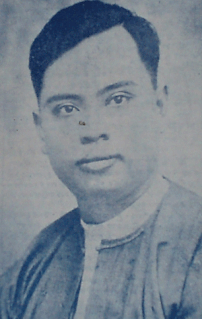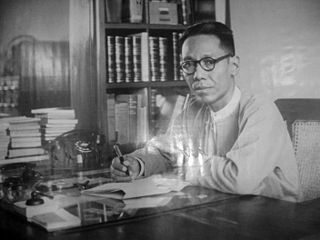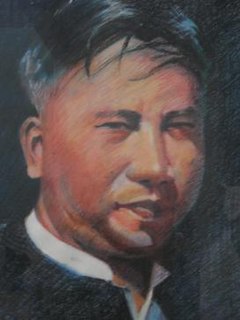Khit San Sarpay (Burmese : ခေတ်စမ်းစာပေ, pronounced [kʰɪʔ sáɴ sàpè] ; lit. "Testing the Age Literature") was a literary movement that emerged in the 1930s British Burma, and is considered the first modern literary movement in the history of Burmese literature. [1] The movement was heavily influenced by modern English literature, and started by young Burmese writers, many of whom were educated in Christian missionary schools. It emerged from the literary contests held by the Burma Education Extension Association. Many short stories in the modern prose appeared in the association's Ganda Lawka Magazine as well as other periodicals. Three collections—Khit-San Ponbyin-mya Volume 1 ("Experimental Tales", 1934), Khit-San Kabya-mya ("Experimental Poems", 1934), and Khit-San Ponbyin-mya Volume 2 (1938), which were edited and selected by came to represent the emerging literary style. [1] [2]

The Burmese language is the Sino-Tibetan language spoken in Myanmar where it is an official language and the language of the Bamar people, the country's principal ethnic group. Although the Constitution of Myanmar officially recognizes the English name of the language as the Myanmar language, most English speakers continue to refer to the language as Burmese, after Burma, the older name for Myanmar. In 2007, it was spoken as a first language by 33 million, primarily the Bamar (Burman) people and related ethnic groups, and as a second language by 10 million, particularly ethnic minorities in Myanmar and neighboring countries.
The literature of Burma spans over a millennium. Burmese literature was historically influenced by Indian and Thai cultures, as seen in many works, such as the Ramayana. The Burmese language, unlike other Southeast Asian languages, adopted words primarily from Pāli rather than from Sanskrit. In addition, Burmese literature tends to reflect local folklore and culture.
The Burma Education Extension Association was a Rangoon (Yangon)-based educational organization founded by JS Furnivall to promote "the intellectual advancement of the country", and the predecessor organization to the Burma Translation Society.
Some of the leading writers of the movement included Theippan Maung Wa, Zawgyi, Min Thu Wun, Maung Htin, Nwe Soe, Maung Thuta, Toe Aung, and E Maung.

Theippan Maung Wa was a Burmese writer, and one of the pioneers of the Hkit San literary movement. The movement searched for a new style and content in Burmese literature before the Second World War starting with Hkit san ponbyin.

Min Thu Wun was a Burmese poet, writer and scholar who helped launch a new age literary movement called Khit-San in Burma. He is the father of Htin Kyaw, president of Myanmar from 2016 to 2018.

Maung Htin was a prolific Burmese writer and journalist, best known for his classic 1947 novel Nga Ba (ငဘ), which portrayed the lives of downtrodden farmers. In 2003, the Government of Myanmar awarded him with a national lifetime achievement award in literature. In 1933, he graduated from Rangoon University with a Bachelor of Arts degree in Burmese.









